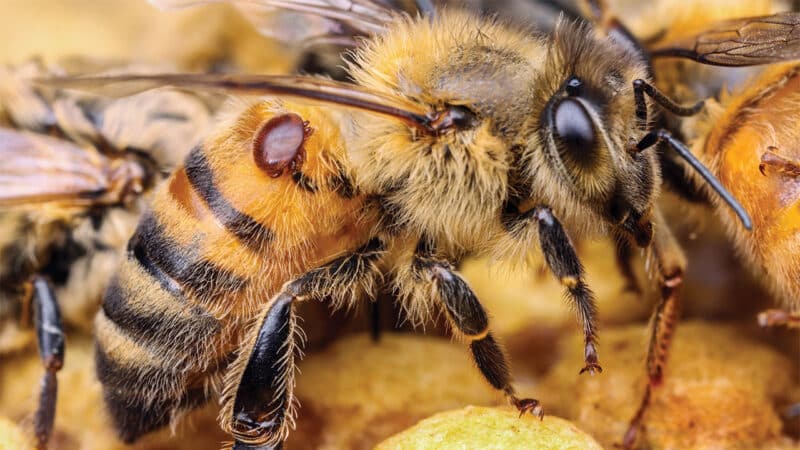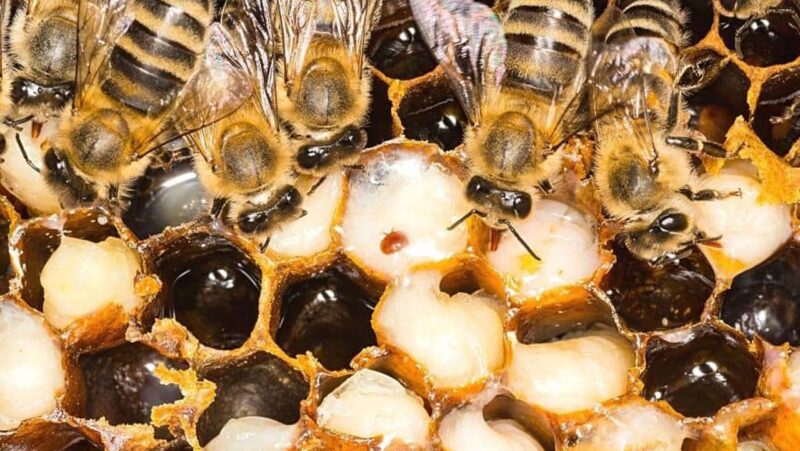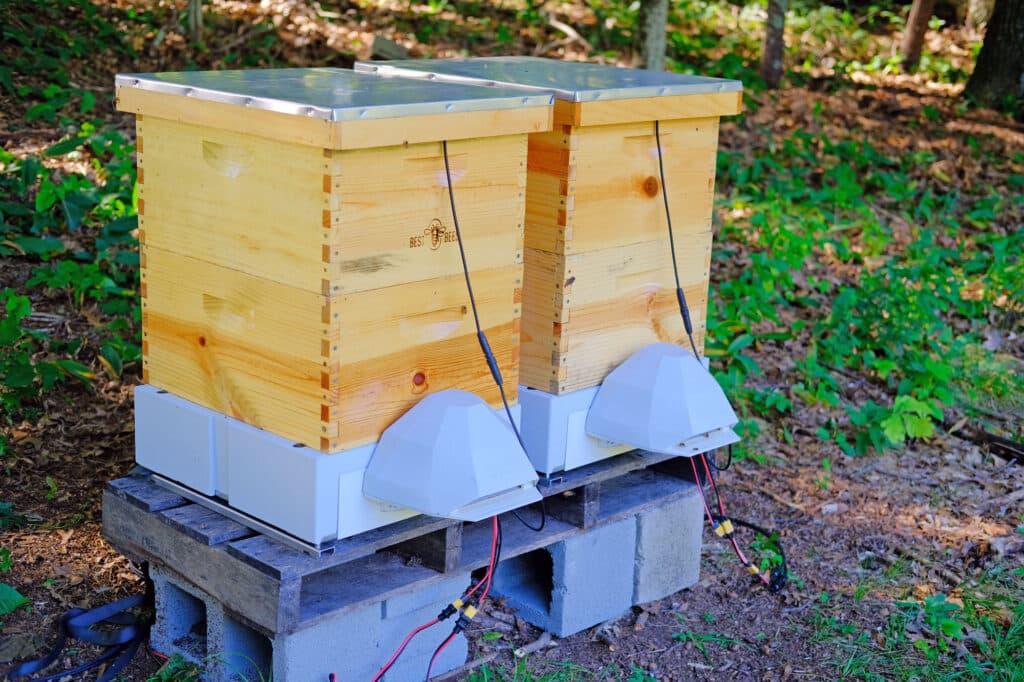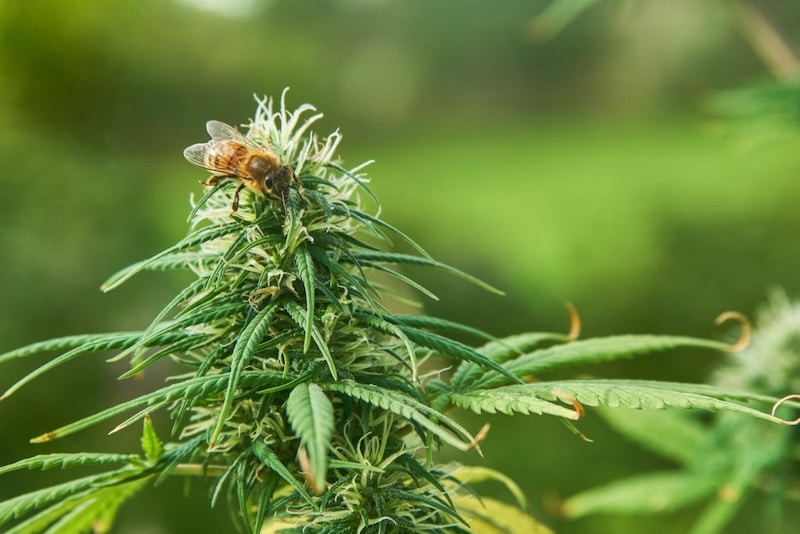Contents:
- What is the Varroa Mite
- Varroa Mite Physical Characteristics and Life Cycle
- Effect on Honey Bee Colonies and Other Bee Species
- How to Detect Varroa Mites
- Varroa Mite Management
- The Economic Impact of Varroa Mites
- The Best Bees Company and Varroa Mites
- FAQs
What is the Varroa Mite
Varroa destructor, the Varroa mite, is a parasitic mite that attacks and feeds on honey bees. These mites are currently the greatest threat to beekeepers and their colonies; varroa is the most serious pest of honey bees, inflicting more damage and higher economic costs than all other apicultural diseases. Without treatment, infected honey bee colonies inevitably collapse within a two to three year period.
Indigenous to Asia, Varroa mites have only been in the United States since the late 1980’s when they were accidentally introduced into Florida. Their original host is the Asian honey bee, Apis cerana, which, unlike the western honey bee, Apis mellifera, has natural defenses against Varroa that come from evolving together over time.
Due to similar physical characteristics, this species was thought to be the closely related Varroa jacobsoni prior to 2000, but taxonomic work published in 2000 revealed that the damage was actually caused by a previously-unidentified species of Varroa – the now-infamous and aptly-named Varroa destructor, which is what we will be referring to throughout the rest of this blog.
Varroa feed on the fat body tissue of both developing and adult honey bees. The fat body is a nutrient-rich, vital organ that acts as an energy storage center and enables energy mobilization. It is the primary site of protein synthesis and contains high levels of guanine. It serves an essential role in hormone regulation, immune response, and pesticide detoxification, which is why it is so harmful that the Varroa mite targets this essential organ.
Varroa Mite Physical Characteristics and Life Cycle
The adult mites have a flattened oval shape, are reddish-brown in color, and are about the size of the head of a pin. Their flattened, curved bodies fit into the abdominal folds of the adult bee and are held there by their own claws and the hairs on the bee’s body.
Adult female Varroa can be found on either adult or immature honey bees; they reproduce on honey bee brood (the developing larvae or pupae). Immature Varroa, the nymphs, are found only on capped brood and the male Varroa mites never leave the brood cells.
Varroa-associated damage is caused by the female Varroa mites. They go through two phases in their life cycle: the phoretic and reproductive phases. The phoretic phase refers to when the female Varroa are feeding on adult honey bees and are passed from bee to bee as they walk past one another in the colony. This is when they are found between the abdominal segments; they puncture the soft tissue between the folds and feed on the fat bodies through the punctures.
To reproduce, the phoretic mites must enter a brood cell before it is capped. Here’s a quick review of the honey bee life cycle: The queen bees lay eggs in cells in the comb of a frame. Three to four days after the egg is laid, a larva hatches and is then fed royal jelly or bee bread for a little over five days before the nurse worker bees in the colony construct a waxy capping over the entrance to the cell. The larva develops into a pupa under the capping and emerges 10 to 18 days later, depending on the type of honey bee it is developing into – worker, drone, or queen.
The adult mated female mite, called the foundress mite, enters the cell of a developing bee larva just prior to capping. The first egg laid develops into a male, the second into a female mite that mates with the male. The eggs are tiny, approximately 0.30 mm long and 0.23 mm wide; they generally cannot be seen by the unaided eye. The male Varroa mite dies inside of the cell shortly after mating with the female mites.
The foundress mite feeds on the developing larva and can transmit several viruses in the process. In worker brood, the foundress can produce one to two mated daughter mites. In drone brood, which takes longer to develop, she can produce two to three mated daughters.
When the bee is fully developed and emerges from the capped cell, the foundress mite and her daughters emerge and attach to adult bees, entering the phoretic stage and starting the cycle over again. The daughter mites will lay eggs in other brood cells after two weeks. Adult female Varroa mites usually live for two months, but can overwinter between the hardened plates of the exoskeleton of adult honey bees.
Effect on Honey Bee Colonies and Other Bee Species
Adult female Varroa mites move over the combs and between adult honey bees. This behavior means that the mites are a very effective virus vector allowing the transfer of viruses between individual bees. Additionally, by feeding on the fat bodies of honey bees, Varroa weakens the bees’ immune systems. This hurts the honey bees’ ability to fight off infections and lowers their tolerance for pesticides.
One of the most telling signs of a Varroa presence in a colony is the occurrence of newly-emerged adult bees with misshapen wings. A virus called deformed wing virus (DWV) is responsible for this symptom. Bees infected with this virus are unable to use their wings properly and will die shortly after emergence.
Additional viruses associated with Varroa mites include Acute Bee Paralysis Virus (ABPV) and Kashmir Bee Virus (KBV). A disease called Parasitic Mite Syndrome (PMS) can be found in conjunction with high Varroa infestation. PMS encompasses a range of symptoms including: a spotty brood pattern, sick brood that appears sunken or melted into the cell (often mistaken for European or American Foulbrood), capped brood cells that are pierced or torn open, lack of eggs and/or developing larvae, and a rapidly decreasing adult population. Colonies suffering from PMS will collapse and eventually die.
While Varroa can not reproduce successfully on other bee species aside from honey bees, the viruses they spread, particularly DWV, can and does infect other bee species, such as bumble bees.
Varroa Mite Impact on Honey Bee Overwintering
Since the Varroa mite feeds on the honey bees’ internal organs known as“fat bodies”, which store and release energy, nutrients, and, importantly, vitellogenin (the source of queen bees’ and winter bees’ longevity), they can have a devastating effect on a colony’s ability to successfully make it through the winter.
In our blog “Beekeeping Tips & Tricks: Overwintering“, we discuss the difference between regular worker bees and “diutinus” bees, also known as winter bees. The queen bee will lay her last eggs of the year through September into early October. These eggs are fed less protein than their warmer weather counterparts, due to the limited pollen resources.
The winter bees that develop from these eggs are physiologically different from normal worker bees; they are born with larger fat bodies. As a result, they live for multiple months, and have lower metabolic rates, which means they do not need to consume as much food.
Varroa mites that are reproducing under the cappings with developing winter bee pupae consume a large amount of the pupae’s fat bodies, leaving the surviving bees weakened — including affecting the development of those crucial larger fat bodies in adult winter bees, reducing their winter lifespans.
How to Detect Varroa Mites
Although they are small, adult mites can be seen by adult bees with the naked eye. They look similar to the bee louse, Braula coeca, which is a harmless, wingless fly that can be found in Apis mellifera colonies. However, there are key differences: Varroa are more oval in shape and have eight legs compared to the louse’s six.
One of the ways to detect Varroa, aside from seeing mites on adult bees, is in the brood cells. Bee brood is usually white, but when the mites are present in the cell, it’s possible to see their reddish-brown color. You can also look for evidence of mites in the brood pattern – if the pattern is patchy, that could be an indication of a Varroa mite infestation. Other indications include uncapped, undeveloped larvae, holes in the cell cappings, and wing deformations in the bee population.
The best method for monitoring Varroa mite populations is through an alcohol wash test. This is done by scooping a half cup of bees, preferably bees that were on a frame with brood, into a jar containing alcohol. The beekeeper then shakes the jar gently for about 60 seconds (Best Bees beekeepers let the bees sit for a minute in the alcohol so the mites have time to come off the bees before shaking to fully dislodge them). Then, they count the number of mites that rest at the bottom. A half cup scoop of bees is equal to 300 bees, so the total mite count is then divided by three to get a percentage. At Best Bees, if that percentage is 3% or higher, then we schedule a treatment for the next visit.
Varroa Mite Management
Traditionally, Varroa mites were controlled solely through the use of a handful of chemicals. This approach has changed over time with new chemicals being available, as well as a variety of non-chemical methods.
When Varroa was first detected in Florida, a Varroa Mite Research Work Group was created to coordinate research and regulatory activity related to the situation. Part of their work was trying to find a successful treatment option to combat the mites. Despite their best efforts, Varroa mites quickly spread throughout the US.
Part of their emergency response, however, to stop the spread of Varroa was to greenlight a chemical treatment, fluvalinate-treated wood sticks. This treatment was very effective, killing over 90 percent of the mites in a colony. However, this only accelerated the development of resistance by Varroa to the treatment. In addition, there were concerns that the fluvalinate was contaminating the honey and wax inside the hive.
Over the last 15-20 years, the most commonly used methods to control Varroa mites have been “hard” acaricides – substances poisonous to mites or ticks. According to BeeAware.org, “Many of these chemicals are commercially available overseas and are easy to apply, economically convenient and do not required a refined knowledge of Varroa mite’s biology and life cycle.”
The problem is that these chemicals could pollute the honey and other hive products, as well as have damaging effects long-term on the bee population and brood development. Additionally, persistent use of these chemicals, and the fact that the active ingredient is stored in low levels in the wax, has led to a growing level of resistance in Varroa mite populations to these chemicals around the world.
To avoid the disadvantages of the hard acaricides, beekeepers turned to “soft” acaricides – naturally occurring organic acids and essential oils, such as Formic acid, Oxalic acid, Thymol, and Lactic acid. These substances are effective against Varroa, with low risk of contaminating bee products and lower probability of resistance in the mite population.
The downside of these soft acaricides is the variability of control compared to their hard acaricide counterparts. The efficacy of the soft acaricides can change depending on the evaporation pressure within the hive, the environmental conditions present, and the outside temperature.
The Economic Impact of Varroa mites
Accurate estimates of Varroa’s overall world impact on beekeeping is difficult to estimate, but it is certain that Varroa mites have killed hundreds of thousands of honey bee colonies, and continue to do so, resulting in major economic losses – billions of dollars worth – for both beekeepers and growers of crops which rely on pollination.
The first, most immediate economic effect of Varroa mites was to make necessary the additional cost of conducting regular treatments to combat their presence. This has caused beekeeper production costs to rise, thereby lowering the profit margin in beekeeping.
The Best Bees Company and Varroa mites
At Best Bees, we are always checking the brood, adult bees, and comb for signs of Varroa, as well as conducting alcohol washes to monitor the mite population. We also treat hives for Varroa frequently, starting early in the season, to make sure we are doing our best to keep the number of mites down.
When we first started back in 2010, one of our goals was to find an alternative to the harsh chemicals typically used to treat for mites. Our search led us to Formic Pro, a low-toxicity organic treatment with Formic acid as its active ingredient. Formic acid is a naturally occurring substance; ants are known to produce it to protect themselves from predators.
Formic acid has the ability to penetrate underneath the wax capping of the brood cells and kill the mites within without harming the baby bees. However, if it is consistently above 80 degrees Fahrenheit, an adverse reaction occurs with Formic Pro and it negatively affects the bees. When this is the case, we treat with Thymol, a chemical compound extracted from thyme. Thymol is the main ingredient in a mite treatment that was cooked up by British beekeeper R. O. B. Manley in the mid 20th century.
Formic acid and Thymol target the mites that are in the brood cells and under the wax cappings of the cells. To target the mites in the phoretic stage – when they’re hitching rides and feeding on the adult bees – we use Oxalic acid. This organic, naturally occurring compound can be found in leafy greens, beets, lentils, and even chocolate! Luckily for us, it has proven to be expeditious at killing phoretic mites with no damage to the bees.
Best Bees is also working to revolutionize beekeeping and mite treatment with our SmartHive Technology. SmartHive Technology is a combination of technology and biodiversity services; it’s the first of its kind on the global market. A SmartHive consists of multiple parts working in tandem:
- The Base: This piece of technology sits under the wooden beehive and has multiple components used to collect data.
- Sensors: There are multiple sensors throughout each hive, to capture acoustics, humidity, weight, temperature, and more.
- Camera: The camera is installed at the front entrance of the hive to record activity in real-time.
- Remote Hub: This on-site hub connects to our software via WIFI.
One of the most exciting aspects of SmartHive Technology is its non-chemical, thermal Varroa mite treatment. Within the SmartHive are robotic thermoregulators that allow our team to remotely increase the temperature of the hive. The bees can withstand high temperatures for a short period of time, but the Varroa mites cannot.
This treatment is proving to be more effective than any chemicals because it can be repeated many times throughout the year. Chemical treatments require specific climate/weather conditions and queen health conditions that generally only allow for a few treatments throughout the year. With SmartHive thermal Varroa treatment, beekeepers are able to continuously fight against multiple generations of Varroa mites until none are left.
This treatment method is also safer for beekeepers as it can be done remotely and the beekeeper does not have to work directly with chemical treatments – which require personal protective equipment.
FAQs
Q: What are Varroa mites?
A: Varroa destructor, the Varroa mite, is a parasitic mite that attacks and feeds on honey bees; it is the biggest threat to managed honey bee hives today.
Q: What does the Varroa mite look like?
A: The Varroa mite has a small, reddish-brown, flattened oval body, with eight legs.
Q: When to treat for Varroa mites?
A: If your mite wash reveals infestation percentages of three percent or more, then you should treat. You should also start treating early in the season.










